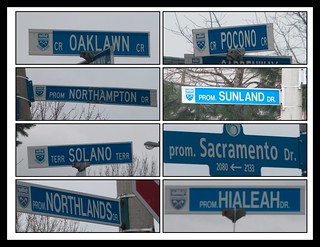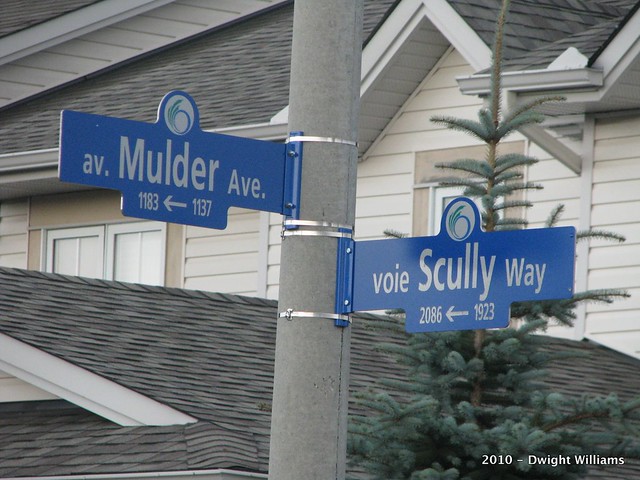Previously, the intersection of Mulder and Scully in Orléans opened up the discussion of streets in Ottawa named for fictional characters and places. But that’s not the only discussion it can open for us here. There’s a second trend it brings to our attention, and that’s the practice of naming streets for places, people and things of distinctly American origin.
After some investigation, one can safely conclude that the practice goes back at least fifty or sixty years. Possibly further than that, but readers will have to judge for themselves on that point.
Among the other examples found after some cursory exploration and research:

At least eight streets in the Fallingbrook South section of Orléans are taken from American racetracks: Sacramento, Hialeah, Northlands, Northampton, Solano, Pocono, Oaklawn and Sunland. These names were originally suggested by the development firm Coscan for use in one section of the Bridlewood neighbourhood in Kanata in 1987. Owing to Kanata City Hall’s standing policy of seeking names of Canadian origin wherever possible, these names were deemed unsuitable there. Hence, one suspects, their appearance on streets in what were then the southern reaches of the Cumberland Urban Area portion of Orléans.

Dating back to 1997, there’s Central Park, a relatively recent addition to the pre-Amalgamation city of Ottawa – not to be confused with the park of the same name in the Glebe – hived off from lands formerly held by the Central Experimental Farm and developed largely by Ashcroft Homes. Most of the streets’ names there are of a uniform theme, centred on the city and state of New York: Central Park itself forms the namesake of the “main drag”, with side streets like Fordham, Rutgers, Manhattan, Bloomingdale, Staten, Grammercy, Gotham and Trump filling out the roster. It’s been slowly filling in over the past decade and a half, with at least one or two new condominium-apartment developments left to be built.
(You may well imagine my personal amusement at finding “Gotham” in Ottawa. But we digress…)

Going back eastward across the city and about thirty or so years earlier in the city’s history, we find these states represented in the Guildwood Estates section of Alta Vista as developed by Garand Homes: Louisiana, Illinois, Florida, Arizona, Michigan and Connecticut. Utah and Ohio are represented in the side streets branching off from Bank Street, where the borders of Billings Bridge and Alta Vista meet, and Maryland in the Rideau View district just within walking distance of Hog’s Back Falls.
Looking back, it doesn’t look like these were a planned series of events. There doesn’t seem to be a specific policy of the various municipalities that existed before Amalgamation that we’re aware of, aside from Kanata’s Canadian-content policy as detailed earlier. This collection of street names is just a historical fact that Ottawa’s stumbled into over the course of the past half-century or so.
Whether or not we want to keep going with this particular accidental habit – and the reasoning behind the choice we end up making – is another matter.


3 comments
Nice observation, Dwight. I like street names (toponomy?) that draw attention to their own natural geography or history. It enhances our sense of the place we’re in, and the continuity or layers of its social roots and branches. Especially where my eyes can’t stop reading a welter of lettered signage.
Does anyone have pet peeves? I go “tsk!” at subdivisions that compensate for lost real trees and streams with leafy street names. I was glad when Castle Mountain near Banff regained its name, after being plucked from its shape and place to become Mt. Eisenhower as an honour to Ike, (whom I like), for a period after WW II.
Your earlier piece on Kanata’s plan and Dr. Stowe, though, converts me to naming streets for people when it’s part of building a structure of knowledge.
Naming places is creative. It creates more than just map references. What do others think?
I often don’t know whether it is warmhearted or cheesy to have names that follow a similar theme in a neighbourhood or subdivision.
An example is the naming of all streets in an area after different types of trees, or different nations of first peoples.
One funny story from my time in Malaysia: the local government in Kuala Lumpur wanted to change the names of smaller streets in the Bukit Bintang (literally “hill star” or “star hill” in English syntax) area and name them after stars, moons and planets. The first street to be changed was Jalan Alor to Jalan Kejora. Jalan literally means means “way” but can mean “street”, and Kejora is the Malay name for the planet Venus.
The funny thing was that the south side of Jalan Alor was known for street food … but the north side was known as an area full of ‘massage parlours’ and frequented by prostitutes.
After about 2 weeks of laughter, hilarious letters to the editor and general public embarrassment, the government sheepishly withdrew the proposal.
A friend’s parents, some years ago, had their rural route address suddenly changed to “Glenview”. Since there was no glen or valley in the neighbourhood , they enquired of their alderman why the name change. He informed them that it was in honour of a retired municipal politician whose first name was Glen.
So Mr. and Mrs. Baglow asked that the municipality arrange with Glen to make an appearance on their street at least once a year, so the inhabitants could gaze on him and make the name Glenview truthful.